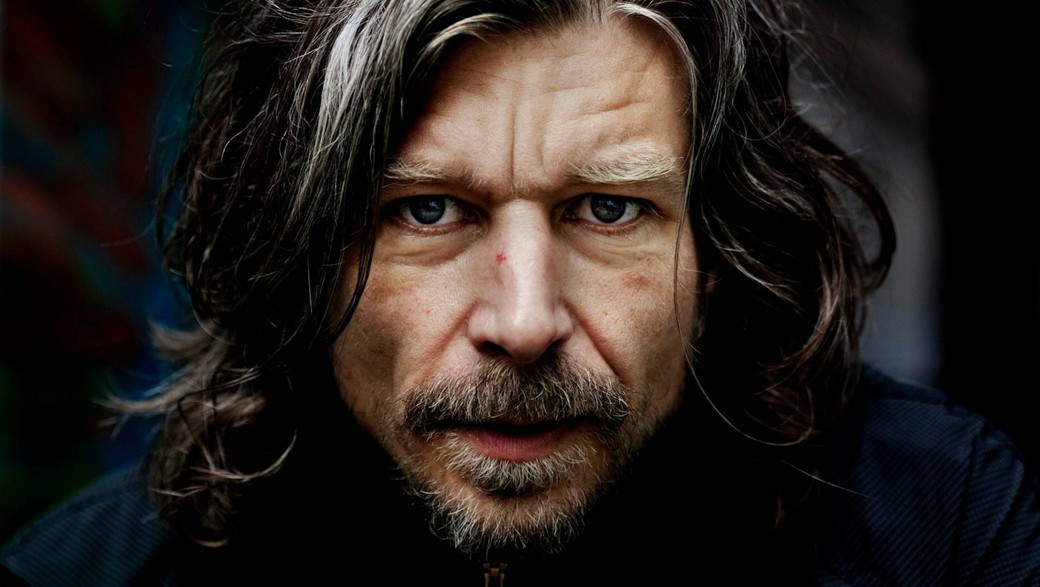
An Imperfect Offering
Some Rain Must Fall
By Karl Ove Knausgaard
Reviewed by Don MacLean
Why has Karl Ove Knausgaard’s 5 volume autobiography made him an international literary sensation?
Karl Ove Knausgaard begins the fifth volume of his autobiography Some Rain Must Fall with a surprising admission. The volume will cover the part of his life spent in Bergen, Norway from 1988 – 2002. Yet, he declares, there are few remnants left of the time in question. He has burned his dairies from those years and only kept a few photographs. He concedes that his memories are fading, incomplete and tinged with shame. The reader is left with the impression that what follows will be a series of imprecise, sweeping reflections on an otherwise long forgotten phase of the man’s life.
 Instead, Some Rain Must Fall is a meticulously detailed account of the formative years in Knausgaard’s development as a writer and a young man. He arrives in Bergen to attend a prestigious writing academy. He’s also in love with a young woman with whom he’s exchanged countless letters but who he has only met once. She too will be arriving in Bergen to attend school. His expectation is thus that he’s on the cusp of a literary break through and sexual and romantic bliss. Alas, his experience at the school does more to shatter his confidence as a writer than to build it. The love affair ends on a hurtful note before it even begins. And so, like so many nineteen and twenty year olds before him, he’s plunged into a sea of insecurity and despair. Will he ever be a good writer? Will he ever publish the sort of novels that have for so long fuelled his imagination and his ambition? Will he find love? These are the burning questions at the heart of the fifth instalment of Knausgaard’s autobiography.
Instead, Some Rain Must Fall is a meticulously detailed account of the formative years in Knausgaard’s development as a writer and a young man. He arrives in Bergen to attend a prestigious writing academy. He’s also in love with a young woman with whom he’s exchanged countless letters but who he has only met once. She too will be arriving in Bergen to attend school. His expectation is thus that he’s on the cusp of a literary break through and sexual and romantic bliss. Alas, his experience at the school does more to shatter his confidence as a writer than to build it. The love affair ends on a hurtful note before it even begins. And so, like so many nineteen and twenty year olds before him, he’s plunged into a sea of insecurity and despair. Will he ever be a good writer? Will he ever publish the sort of novels that have for so long fuelled his imagination and his ambition? Will he find love? These are the burning questions at the heart of the fifth instalment of Knausgaard’s autobiography.
This reader, meanwhile, has his own questions. Why has Knausgaard become an international literary sensation? Why have the first four volumes of his autobiography captured people’s imaginations they way they have? Based on Some Rain Must Fall the answers are not necessarily obvious, for a couple of significant reasons. The first is the book’s uneven prose. To be sure, there are wonderful stretches on almost every page. Knausgaard’s depictions of Bergen’s rain soaked streets perfectly match his own often melancholy temperament. Nonetheless almost every other page is also marred by some unseemly prose. Knausgaard has a propensity for run on sentences. When well put together, there is nothing wrong with sentences that stretch out over 4 or 5 lines of a page. Knausgaard’s, however, suffer from a problem all too familiar to undergrad students and the professors who must grade their papers. That is to say, they are too often grammatically unsound. He seems to think a few well placed commas is all an unduly long sentence needs to render it grammatically correct. It almost pains me to write about something as tedious as poor sentence structure, but it must be pointed out. Some Rain Must Fall suffers for it.
The other reason has to do with the arc of Knausgaard’s development. He desperately wants to live and, equally desperately, wants to write. He’s a young man with seemingly boundless energy and insatiable yearnings: for music and alcohol, for literature, for women and for love. Moderation is not an idea with which he is familiar. Much of his life seems to have been spent in a drunken haze. He is constantly out with his brother Yngve and their mutual friends drinking and smoking. Too much alcohol, however, renders him unpredictable: he steals bikes for fun and is prone to angry outbursts. On one evening after too much to drink he hurls a beer mug at Yngve, hitting him in the face. He rushes out of the bar after seeing the blood stream down his brother’s cheek.
On other nights, his drunkenness leads to infidelity. On one such occasion he meets a woman at a bar and, within minutes, they step into a taxi, rush back to his place, tear their clothes off and have sex. He wakes up the next morning and sees a beautiful but unfamiliar face lying next to him. He’s horrified: what has he done? How could he possibly be unfaithful when he has such a wonderful girlfriend who loves him with all her heart? He’s consumed by regret and guilt. He demands that the woman dress, ushers her to the door and begs her to never say a word to anyone about what transpired. The reader detects a pattern which, in turn, prompts an expectation. At some stage, one feels, Knausgaard will start to drink less, grow less impulsive and act more responsibly where women in his life are concerned. In other words, he’ll grow up.
The reader waits and waits. Indeed, that Knausgaard writes so much about his incessant drinking, his perpetual preoccupation with women and the self loathing it inspires is precisely why he has been accused of narcissism. There is much truth in this charge. For his excessive preoccupation with himself is at the expense of a larger vision. He writes very little, for example, about Norway as a country – the politics or the history or the culture. There’s even less written about the wider world. There is a reference to 9/11, but precious little else. What are his politics? Where does he see himself in the world? The reader ends the book none the wiser on these questions then when she started. Similarly, he’s a student of literature but the insights into the books he reads are few and far between. He refers to writers he has read without ever actually telling the reader why he loved or loathed so and so.
Yet for all his narcissism there is something about Knausgaard’s life story that draws in the reader. His appeal begins with his insatiable appetites and his love for life. But it goes deeper than that. It’s also his elevation of the utterly mundane as worthy of literary treatment. Knausgaard writes about his coffee in the morning or the dinner he had that evening. He seemingly mentions every cigarette he’s smoked, which is many. (To paraphrase the Canadian comedian Ron James, Knausgaard smokes like its a cure for cancer.) He describes countless nights out with friends at bars. In some writer’s hands, the mundane becomes the tedious. In Knausgaard’s hands, the effect of elevating the mundane is to elevate a life. It’s one of his great gifts as a writer.
There is also his vulnerability and the frank, shameless way he reveals it to the reader. For all of his love of life, he’s also brooding and, as a young man, often awkward around women. Like most young men, he must find ways to compensate for a lack of physical intimacy. Knausgaard describes how he would hide books with pictures of beautiful women in his pants, go the washroom and masturbate. His tortured relationship with his father leaves him desperate for approval and forever insecure about his writing. He persuades himself that he isn’t smart or wise enough to ever be a literary writer. When he’s at dinner parties with his writerly friends he is so intimidated that he often is suddenly quiet and withdrawn and plagued by dark thoughts. It’s this vulnerability with which many readers, despite the book’s recurring flaws, identify.
Related: A Good Life, A Flawed Novel.
He then meets Tonje. Like a school boy, he falls madly in love. By this point in his life, women are drawn to him and he is at ease around them. Tonje is different. He is at once tentative and awkward around her. He doesn’t lust after her, like he did so many other women. Such a feeling is too shallow; doesn’t come close to matching the depth of his love. So they instead get to know each other relatively slowly: they have a magical walk to her home on a cold, snowy night. They have tea as the day dawns. But when he leaves her home he can’t muster the courage to give her a hug, let alone a kiss. Intimacy would have to wait.
At this relatively late point in the book it appears as though Knausgaard is changing. He is less self absorbed. He is still writing exclusively about his life, his struggle, but his focus is more on the death of his father, the passage of time and his evolution as a writer. He finally establishes the discipline required to produce a novel. To spend an evening drinking would jeopardize a rhythm he struggled so hard to discover and which was so conducive to prose worthy of praise and publication. So he stays put days and evenings on end to the point that Tonje begins to suffer for it. She wants to be out with him, wants them to together experience the world outside of their little home. He promises that the endless nights spent writing would cease the moment his novel is finished and published. He keeps his word. The novel is published to great acclaim. Normalcy – and happiness – returns to their lives.
The reader’s expectation of Knausgaard’s growth is, at long last, realized. He’s an accomplished writer and happily in love. Doubts, however, persist. Can his contentment possibly be sustained? Will he and Tonje still be together by the book’s end? Or will Knausgaard find a way to sabotage both his and Tonje’s happiness? Is it only a matter of time before he makes another horrible transgression? For all of his new found love and happiness the reader senses Knausgaard’s dark, brooding centre remains intact. For him at least, the light will never extinguish the darkness.









